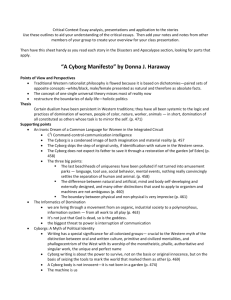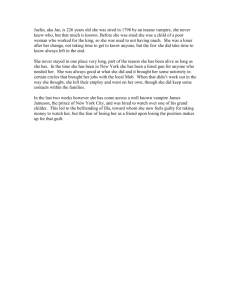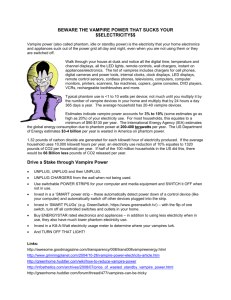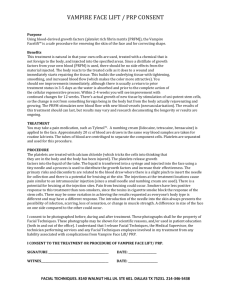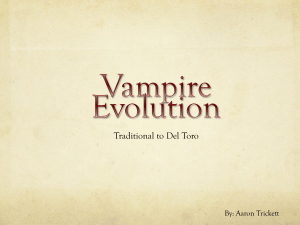The Vampire and the Cyborg Embrace
advertisement
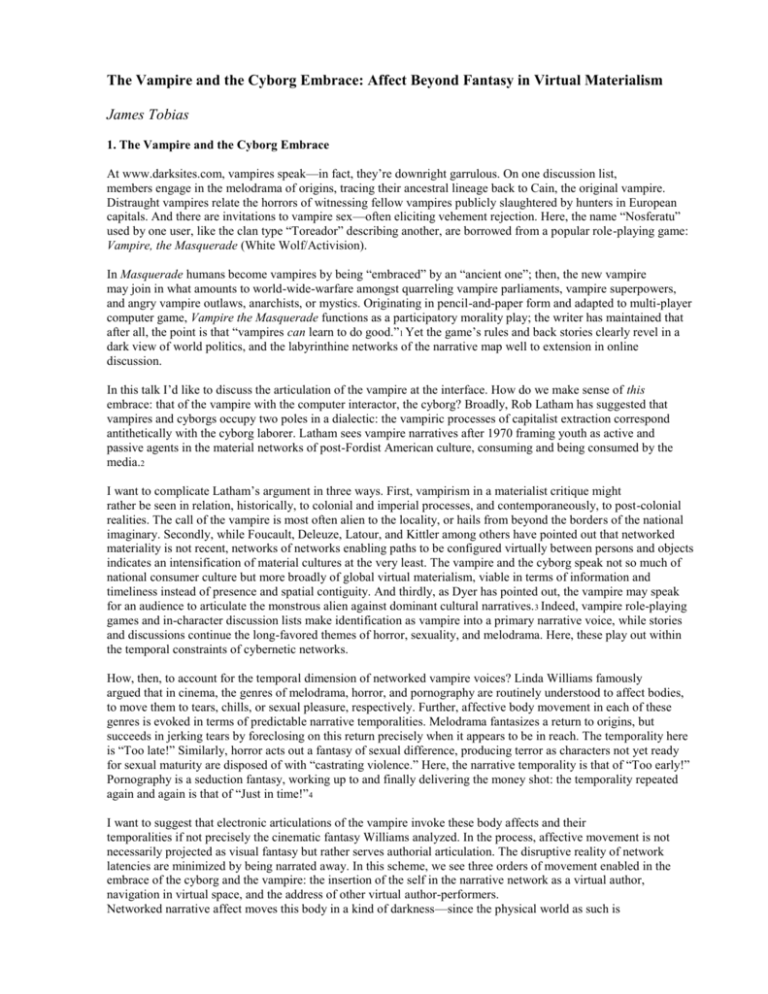
The Vampire and the Cyborg Embrace: Affect Beyond Fantasy in Virtual Materialism James Tobias 1. The Vampire and the Cyborg Embrace At www.darksites.com, vampires speak—in fact, they’re downright garrulous. On one discussion list, members engage in the melodrama of origins, tracing their ancestral lineage back to Cain, the original vampire. Distraught vampires relate the horrors of witnessing fellow vampires publicly slaughtered by hunters in European capitals. And there are invitations to vampire sex—often eliciting vehement rejection. Here, the name “Nosferatu” used by one user, like the clan type “Toreador” describing another, are borrowed from a popular role-playing game: Vampire, the Masquerade (White Wolf/Activision). In Masquerade humans become vampires by being “embraced” by an “ancient one”; then, the new vampire may join in what amounts to world-wide-warfare amongst quarreling vampire parliaments, vampire superpowers, and angry vampire outlaws, anarchists, or mystics. Originating in pencil-and-paper form and adapted to multi-player computer game, Vampire the Masquerade functions as a participatory morality play; the writer has maintained that after all, the point is that “vampires can learn to do good.”1 Yet the game’s rules and back stories clearly revel in a dark view of world politics, and the labyrinthine networks of the narrative map well to extension in online discussion. In this talk I’d like to discuss the articulation of the vampire at the interface. How do we make sense of this embrace: that of the vampire with the computer interactor, the cyborg? Broadly, Rob Latham has suggested that vampires and cyborgs occupy two poles in a dialectic: the vampiric processes of capitalist extraction correspond antithetically with the cyborg laborer. Latham sees vampire narratives after 1970 framing youth as active and passive agents in the material networks of post-Fordist American culture, consuming and being consumed by the media.2 I want to complicate Latham’s argument in three ways. First, vampirism in a materialist critique might rather be seen in relation, historically, to colonial and imperial processes, and contemporaneously, to post-colonial realities. The call of the vampire is most often alien to the locality, or hails from beyond the borders of the national imaginary. Secondly, while Foucault, Deleuze, Latour, and Kittler among others have pointed out that networked materiality is not recent, networks of networks enabling paths to be configured virtually between persons and objects indicates an intensification of material cultures at the very least. The vampire and the cyborg speak not so much of national consumer culture but more broadly of global virtual materialism, viable in terms of information and timeliness instead of presence and spatial contiguity. And thirdly, as Dyer has pointed out, the vampire may speak for an audience to articulate the monstrous alien against dominant cultural narratives. 3 Indeed, vampire role-playing games and in-character discussion lists make identification as vampire into a primary narrative voice, while stories and discussions continue the long-favored themes of horror, sexuality, and melodrama. Here, these play out within the temporal constraints of cybernetic networks. How, then, to account for the temporal dimension of networked vampire voices? Linda Williams famously argued that in cinema, the genres of melodrama, horror, and pornography are routinely understood to affect bodies, to move them to tears, chills, or sexual pleasure, respectively. Further, affective body movement in each of these genres is evoked in terms of predictable narrative temporalities. Melodrama fantasizes a return to origins, but succeeds in jerking tears by foreclosing on this return precisely when it appears to be in reach. The temporality here is “Too late!” Similarly, horror acts out a fantasy of sexual difference, producing terror as characters not yet ready for sexual maturity are disposed of with “castrating violence.” Here, the narrative temporality is that of “Too early!” Pornography is a seduction fantasy, working up to and finally delivering the money shot: the temporality repeated again and again is that of “Just in time!”4 I want to suggest that electronic articulations of the vampire invoke these body affects and their temporalities if not precisely the cinematic fantasy Williams analyzed. In the process, affective movement is not necessarily projected as visual fantasy but rather serves authorial articulation. The disruptive reality of network latencies are minimized by being narrated away. In this scheme, we see three orders of movement enabled in the embrace of the cyborg and the vampire: the insertion of the self in the narrative network as a virtual author, navigation in virtual space, and the address of other virtual author-performers. Networked narrative affect moves this body in a kind of darkness—since the physical world as such is placed out of temporal sync, out of focus, out of sight. With this vampiric flight of the body, the interactor moves by puppeting, sending avatars to do her bidding, causing material data structures elsewhere to re-align. The pre-modern remnant of the vampire and the post-modern legend of the cyborg thus invoke not only a cyberspatiality but a cybertemporality—an endless night. As regards the networked self, we might say that while the vampire cuts, the cyborg pastes. The cyborg-vampire embrace reveals in negative the dark transit of the affective labor working to articulate the self within the circuits of virtual materialism. 2. Transgender In the conclusion to her 1995 study of telematics and gender, The War of Desire and Technology at the Close of the Mechanical Age, writing early on in the popularization of the world wide web, Roseanne Allucquere Stone wrote that merely being spoken by a discourse is a kind of “quiet death.” For Stone, it was not the case that male and female gender differences collapse at the interface simply because physical identity is masked. Rather, virtual systems offer new tools for articulating gender as human and computer systems evolve into more complex assemblages.5 De-coupling virtual gender from physical gender would be one form of articulating our way out of that quiet grave – a species of becoming undead. Stone was working on an elaboration of Donna Haraway’s earlier proposal of an ironic cyborg writing. Haraway had maintained in 1985 that the boundaries between human and animal, machine and human, material and immaterial had become permanently imprecise. Haraway saw gender as only one more boundary among others now subject to dissolution under the terms of technoscientific knowledge production. With modernist unities of organism, machine, and matter dissolved, feminist technoscience could mount an attack on the historically constructed categories of race, sexuality, and property formerly maintained through those modernist unities. 6 An ironic conception of a cyborg subject would work against anti-science metaphysics, which tended to place technology within what Haraway dismissed as a “demonology.” In other words, at approximately the historical moment that Dyer observes that sexual minorities had learned to enunciate within mass culture through the projection of vampire fantasy, Haraway proposes that women identify with the monstrously technological power of the cyborg: cyborgs would not be dominated by machines, nor by gender articulated as some essential category of identity.7 For Stone, writing almost 10 years after Haraway’s “cyborg manifesto,” the mobilities of corporeal positioning enabled by medical bioscience combined with transnational data networks subjects the situatedness of Haraway’s cyborg to a newly problematic dimension of technological globality. Where Haraway saw the cyborg as occupying a point within global capital at which to produce and network knowledge with others, Stone’s cyborg moves through cybernetic networks. Thus, her emphasis shifts from the datum of corporeal knowledge to the ways in which meaning “struggles to escape its customary channels.”8 But because now embodiment may be either physical or virtual, Stone re-introduces demonology to cyborg cultural theory. Stone’s cyborg is a re-writing of Anne Rice’s “Vampire Lestat”: here, a being living in cybernetic knowledge systems, faced with the task of continual adaptation across changing boundaries. Stone’s Lestat is immersed in cultural theory, earns a Ph.D. in anthropology, and lusts for human blood. He is still a poignant figure, seeing “humans transfixed by the arrow of time but in addition by the sword of subject position.”9 Stone suggests that for this border body in virtual systems, where networks are “identity factories” and bodies are “meaning machines,” the transgendered body is the screen on which relations of power project gender. 10 Stone’s cyborg vampire disrupts gendered power relations by passing on the “dark gift” of a transgendered gaze: “Ultimately, the gaze of the vampire is our own transfigured and transfiguring vision. Claiming that vision is our task and our celebration,”11 Stone herself acts out this identity, whether in photos of herself dressed and made-up in her preferred goth style posted on the internet12 or in comedic performances that she calls “stand-up theory.” At one academic conference in 1997, Stone’s stand-up theory combined (badly) sung show tunes re-written to highlight transgender issues, theoretical excursa on the dark gift of vampire subjectivity and corporeality as prosthesis, and audience participation sequences in which she presented an imaginary spot on the palm of her hand as a remapped clitoris, through which to reach orgasm, but only if the audience believes she can, and, shades of Peter Pan, is willing to shout its approval of her ability to feel virtual pleasure. Stone’s performative orgasm is articulated according to the logic of the “Just in time!” narrativity that Williams saw working in pornography. Instead of the audience masturbating to the image, Stone is virtually masturbated by the audience, whom she has, as it were, eating out of the palm of her hand. Stone has been characterized by more than one critic as a hard case of technological determinism. 13 Her transgender pornography celebrating a vampiric subjectivity puppeting a prosthetic body is turned into a kind of “it’s too early!” horror story by critic Sue-Ellen Case. Case suggests that committing the body to one or the other gender through contemporary medical technology will turn out to be premature, as future developments in biomedicine will render any such sexual re-assignment as outdated. For Case, Stone’s celebratory vampire lurks only to fall to the horror of sexual difference, with transexual surgery bizarrely implied to be a violent castration of the future potential for technologized sexual ambiguity!14 In any case, the problematic of temporality playing out in terms of articulating a virtual vampire is a properly historical one. The assertion that Stone made seems to have been wrong—virtuality does afford transgender identity play, but today, bodies “hook up” over the ‘net primarily by projecting stable sexual identities configured along the rather more banal lines of mainstream smut, and warranted by the date that results. 3. Transhuman “But computerisation has not put an end to nations and ethnic groups.” -- introductory intertitle, Ghost in the Shell Stone’s broader point as to the potency of the cyborg-vampire embrace perhaps helps us to make sense of, for example, the violently felicitous union of cyborg and vampire a Japanese animated film released for the global film market shortly after the appearance of Stone’s book. Ghost in the Shell (Mamoru Oshii, 1995) follows cyborg assassin Motoko Kusanagi as she is hunted by a vampire-like “Puppet Master” whose traces appear everywhere in the virtual, but whose body can be found nowhere. Like the physical world of the film, virtual space is owned and operated by a military-industrial complex whose own internecine rivalries determine that this Puppet Master, a new form of emergent intelligence, must be deleted. So, it seeks to escape beyond the virtual. Cyborg humanity in the form of Kusanagi turns out to be the destination to which the vampiric Puppet Master will defect. Once located in a body, he can be granted political asylum from virtual persecution. Here, the liabilities of the virtual are portrayed—fragmentary and multiplicitous, flexible and evanescent, virtual identity is too fluid, too tenuous whether for the state or for new forms of life. But rather than warrant virtual identity in a human body, Motoko and the Puppet Master merge in an unholy union baptised by the cataclysmic fire of a military onslaught. In the conflagration Motoko’s body and the temporary female body being vampirized by the PuppetMaster are damaged beyond repair, but, in the nick of time, and while poignantly immobilized at each other’s side, achieve mutual penetration remotely through a network connection. 15 A colleague reclaims the remains of the vampire-cyborg union and gives Motoko a new body. What is depicted here is, in effect, a seduction of the cyborg by the vampire, according to the narrative temporality of the pornographic—“just in time!” Motoko’s resulting physical body allows movement in real space, while her virtual body guarantees unlimited access to the ‘net. Further, while her physical body guarantees protected status as a defector from the virtual, her virtual existence allows the physical body to be reconfigured or replaced as needed. Motoko’s physical and virtual bodies now circulate in a mise-en-abyme of affect and mobility—pleasure without end in a mutual immersion of the physical and the virtual. But Motoko’s rebirth is perverse: her final configuration is in the body of a small, dark-haired girl. In darkhued tresses and antique style of dress, Motoko resembles the goth girls who post their images on darksites.com. More iconographically, she might be yet another hybrid: a cross between a traditional Japanese doll and the real-life Alice, photographic subject of Charles Dodgson (Lewis Carroll). Motoko the cyborg embraces vampiric mobility as the looking glass of the self shatters under a violent attack on the remainder of the human. Reincarnated as a small girl on the other side of the paradigm of hybridity, the new child whom Motoko has become stands on the edge of reality to survey our world—a very serious Alice at play in a very dangerous Wonderland. Susan Napier argues that Motoko represents Haraway’s bad-girl cyborg, a woman who takes up the tools of technoscience for political work.16 But Motoko’s reincarnation as a transhuman child revising the use of immersive technologies produced for state warcraft resembles more the becoming-woman of Deleuze and Guattari’s Thousand Plateaus. After she embraces the vampiric mobility of the puppet-master, instead of her earlier feelings of anxiety and hope, she senses rather an endless capacity for spatial translation: “the net,” she says, “is vast and infinite.” Motoko has become a creature of affect. Affect, in Deleuze and Guattari’s formulation, is the experience of bodies that produce translations and transformations, beings built for shifting borders, or, as they put it, “the abstract machine of the waves.”17 This machinic assemblage exists as a temporal singularity, and as such moves in terms of affect: You have the individuality of a day, a season, a life (regardless of its duration) – a climate, a wind, a fog, a swarm, a pack (regardless of its regularity). Or at least, you can have it, you can reach it. A cloud of locusts carried in by the wind at five; a vampire who goes out at night, a werewolf at full moon.18 For Motoko, the vampire as a deterritorialized body feeding on networks exists precisely in terms of its embrace with the cyborg instrument—in their embrace, the “circulation of affect” results.19 Finally, Motoko stands, a non-similar reproduction of herself, at the dark edge of an impossibly high garden overlooking a cybernetic urbanity that has swallowed its own horizon. Neither thing nor subject; rather, her just-in-time seduction installs her in the demonology of virtual materialism: a logic of affect through which networked bodies impel the self to act. Notes 1. “Live chat with Justin Achilli” March 10 2000, (June 30, 2003), <http://www.whitewolf. com/Games/Pages/chattranscript3-10-00.html>. 2. Rob Latham, Consuming Youth: Vampires, Cyborgs, and the Culture of Consumption (Chicago: University of Chicago Press, 2002). 3. Richard Dyer, “Children of the Night: Vampirism as Homosexuality, Homosexuality as Vampirism” in Sweet Dreams: Sexuality, Gender, and Popular Fiction, ed. Susannah Radstone (London: Lawrence & Wishart Ltd., 1988), 64. Dyer notes that the vampire has been a trope of same-sex desire from before Stoker’s Dracula: historically earlier representations of the vampire tend to evoke horror; later ones turn that horror to celebration. 4. Linda Williams, “Film Bodies: Gender, Genre, and Excess,” in Film Theory and Criticism 5th ed., ed. Leo Braudy and Marshall Cohen (New York: 1998), 712. 5. Roseanne Allucquere Stone, The War of Desire and Technology at the Close of the Mechanical Age (Cambridge: MIT Press, 1995), 173 - 174. 6. Donna Haraway, “A Cyborg Manifesto: Science, Technology, and Socialist-Feminism in the late 20th Century” in The Cybercultures Reader, ed. David Bell and Barbara Kennedy (New York: Routledge, 2000), 293– 297. 7. Ibid., 315. 8. Stone, 177. 9. Ibid., 179-180. 10. Ibid., 180-181. 11. Ibid., 183. 12. See, for example, http://www.sandystone.com. 13. Sue-Ellen Case, The Domain-Matrix: Performing Lesbian at the End of Print Culture (Indianapolis: Indiana University Press, 1996), 120. 14. Ibid., 120. 15. The way the film projects the mutual grounding of the virtual and the physical as two networked female bodies one of which speaks in masculine voice recalls not only Stone’s notion of online gender as transgender by default, but simultaneously, Case’s response to Stone’s cyborg vampire: lesbian networking practices as a model for the technocultural production of identity. 16. Susan Napier, Anime from Akira to Princess Mononoke: Experiencing Contemporary Japanese Animation (New York: Palgrave, 2001), 106 – 107. 17. Gilles Deleuze and Felix Guattari, A Thousand Plateaus: Capitalism and Schizophrenia (Minneapolis: University of Minnesota Press, 1987), 262. 18. Ibid., 262. 19. Ibid., 260. Bibliography Case, Sue-Ellen. The Domain-Matrix: Performing Lesbian at the End of Print Culture. Bloomington and Indianapolis: Indiana University Press, 1996. Deleuze, Gilles, and Felix Guattari. A Thousand Plateaus: Capitalism and Schizophrenia. Minneapolis: University of Minnesota Press, 1987. Dyer, Richard. “Children of the Night: Vampirism as Homosexuality, Homosexuality as Vampirism.” In Sweet Dreams: Sexuality, Gender, and Popular Fiction, ed. Susannah Radstone, 47-72. London: Lawrence and Wishart, 1988. Haraway, Donna J. “A Cyborg Manifesto: Science, Technology, and Socialist-Feminism in the late 20th Century.” In The Cybercultures Reader, ed. Barbara Bell and David Kennedy, 291-324. New York: Routledge, 2000. Kittler, Friedrich. “Dracula’s Legacy.” In Essays: Literature, Media, Information Systems, ed. John Johnston., 5084. Amsterdam: OPA, 1997. Latham, Rob. Consuming Youth: Vampires, Cyborgs, and the Culture of Consumption. Chicago: University of Chicago Press, 2002. Napier, Susan. Anime from Akira to Princess Mononoke: Experiencing Contemporary Japanese Animation. New York: Palgrave, 2001. Stone, Roseanne Allucquere. The War of Desire and Technology at the Close of the Mechanical Age. Cambridge: MIT Press, 1995. White, Luise. Speaking with Vampires: Rumor and History in Colonial Africa. Berkeley: University of California Press, 2000. Williams, Linda. “Film Bodies: Gender, Genre, and Excess.” In Film Theory and Criticism, edited by Leo Braudy and Marshall Cohen, 701 – 715. New York: Oxford University Press, 1999. James Tobias is Assistant Professor of Digital Media Studies in the English Department and the Program in Film and Visual Culture at the University of California, Riverside.
